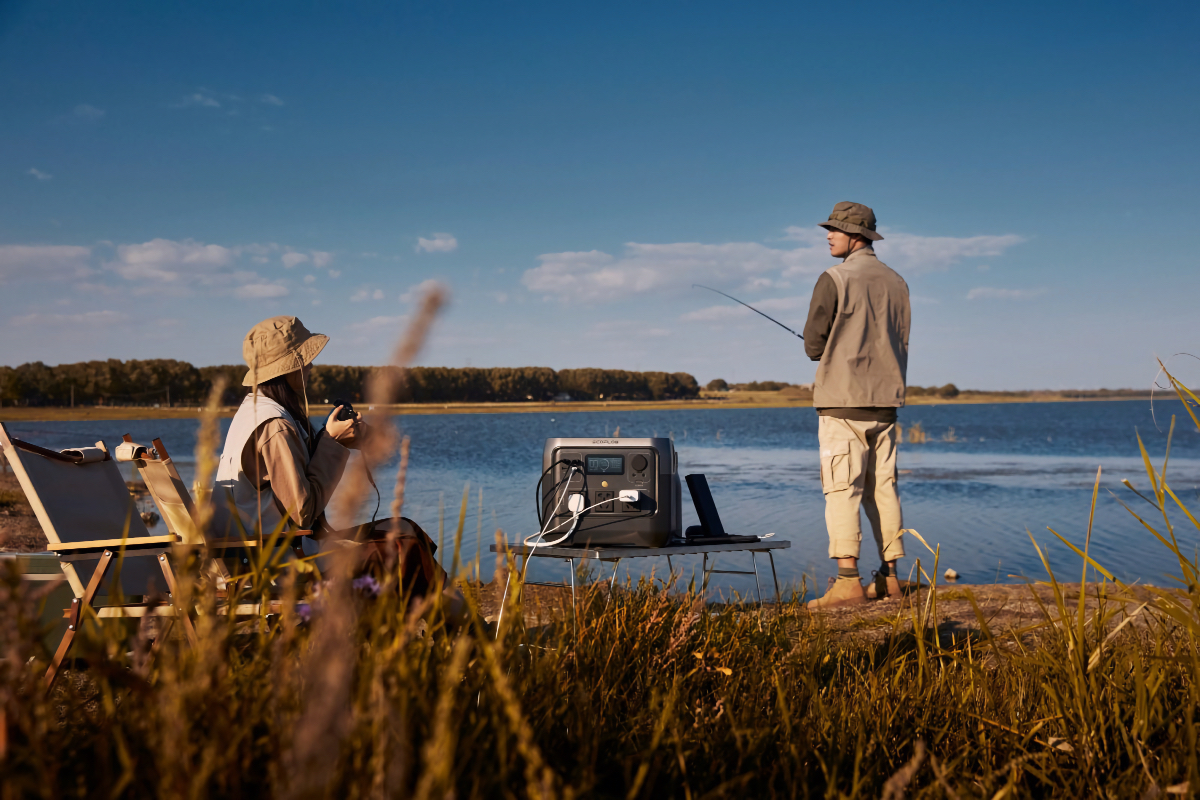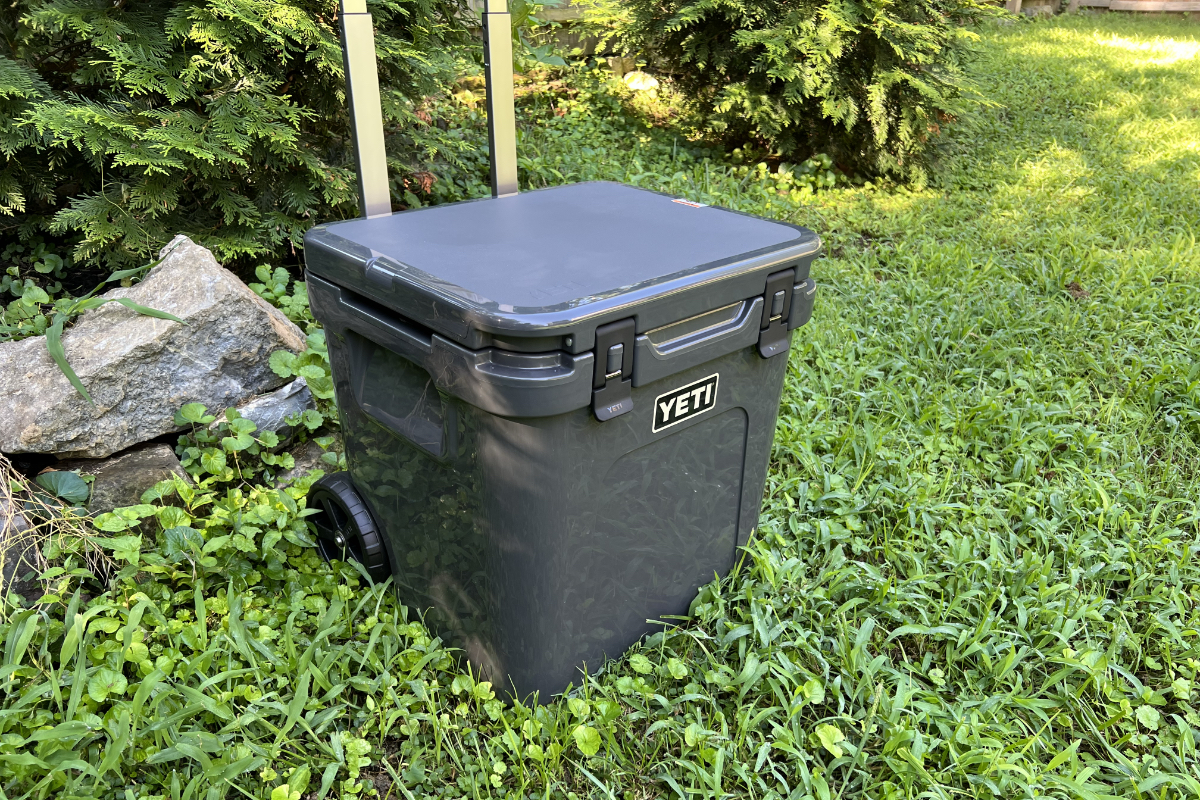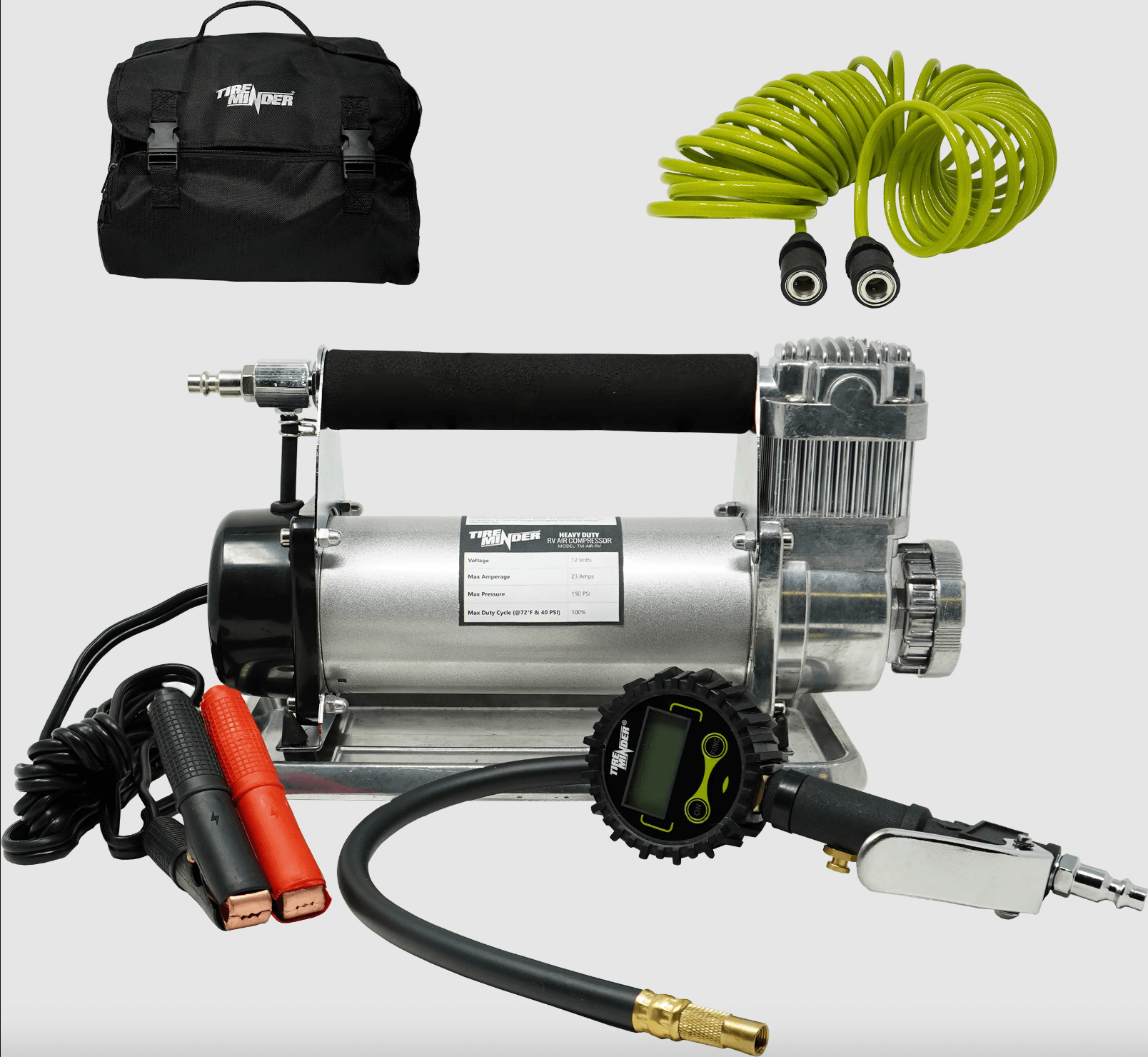The Best RV GPS
Image Caption:
When GPS devices first became popular for automotive and RV travel they were little more than crude navigational tools that would sometimes get you where you wanted to go. Today, things are very different. Not only do these wonderful devices provide routing assistance, they offer a wide range of other features that augment a smartphone and, in some cases, can even double as a full-featured tablet with Bluetooth, Wi-Fi connectivity and other nice additions, like a dash camera.
What to Look for in an RV GPS
As we approached this review, we wrote down a few things that we felt were important for a good GPS to offer a motorhome user. Since operating a large motorhome is very different from driving an automobile, the GPS has to be different as well. For example, because of a motorhome’s dimensions, not every road will be accessible. Some roads have height and weight restrictions, and nothing ends a nice vacation faster than trying to fit a 12-foot, 6-inch coach under an 11-foot, 8-inch bridge. That’s why we tested each of these GPS units to see what happened when traveling on a road with a known low-clearance underpass.
Most RV-specific GPS devices require profile programming to define weight, number of axles, height, etc., so that the unit can match specified routes safely. When driving the dinghy vehicle, the GPS should allow for an easy profile change and route accordingly, which could likely be shorter and faster.
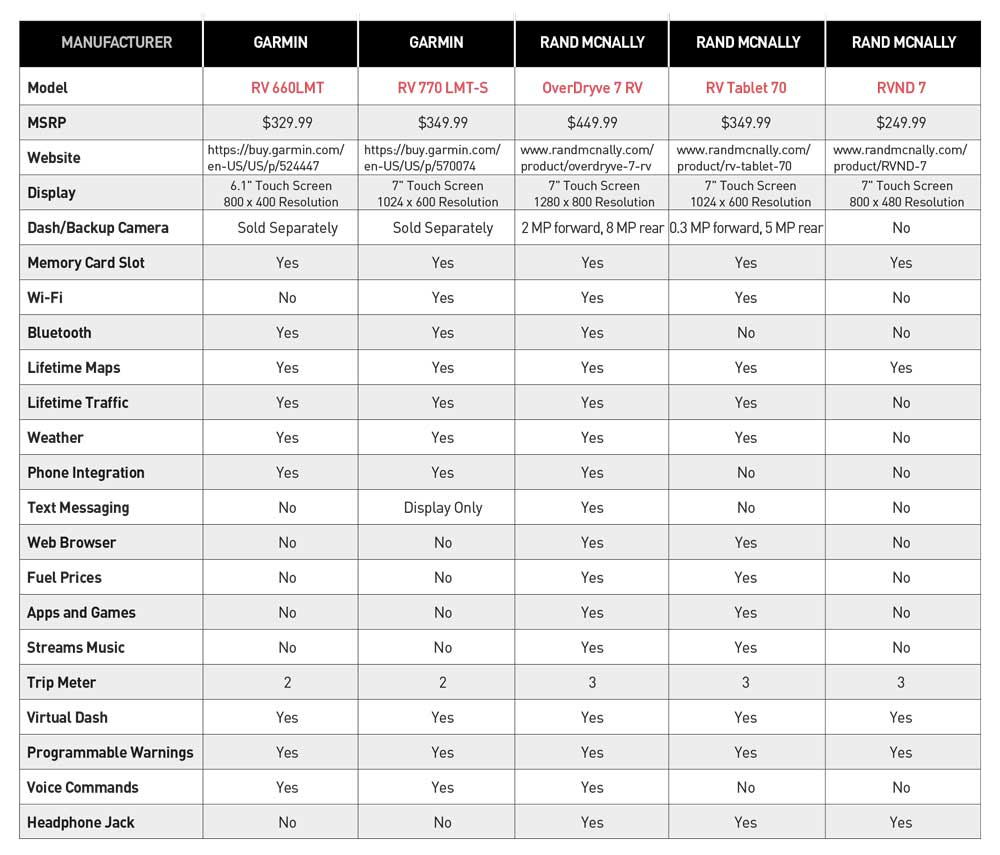
GPS Comparison Chart
Another difference between driving an automobile and a motorhome is the difficulty in changing lanes, especially when approaching splits and exits that require you to be in certain lanes. During our testing process, we specifically evaluated the graphic presented when approaching an interchange, just to make sure it offered a clear, easy-to-see image that safely navigates the driver to the proper lane.
One important aspect of any GPS is the ability to upgrade maps and the operating system. A few years ago, updating a GPS required downloading a program to a computer. This was usually done by using a memory card to download the new maps or by plugging the GPS into a computer for the upgrade. With a Wi-Fi-enabled unit, it’s a simple click of a button, and the maps and software are updated as new versions become available.
Many states now have laws that prohibit distracted driving, which in some cases means that you have to use a hands-free device when talking on a cellphone.
Professional/commercial truck drivers have been subject to this law for years and since operating a large motorhome is similar to a big rig, hands-free cellphone use is something we should practice as well. Many of the GPS devices now feature Bluetooth pairing with a smartphone, which allows placing and receiving calls without handling the phone. Hands-free phone operation is therefore another important feature to consider when searching for a suitable GPS unit.
Traveling offers enough challenges without having to worry about where to get fuel, or how far away the next rest area is, or where to eat or camp for the night. Many of these RV-specific GPS units offer an easy search function with destinations that are (in some cases) specific to motorhome travel. Some models have a specific button, so the user can look at the amenities offered at the next exit.
Saving Routes
Another important thing to look for is the ability to store previously searched destinations or current location in the event you want to come back. The ability to program and edit various warnings is another recent development in GPS technology that we really like. Some units have detailed user-definable settings that will warn of upcoming or current features on the route such as toll roads, sharp curves, hills, state lines, time-zone changes and speed limits. Most GPS units have the ability to display the current speed, and some even offer a color-coded display to indicate when traveling above the speed limit.
If you already have an automotive-based GPS and plan on using it in the motorhome as well, we advise you rethink that strategy. Unless your current GPS allows vehicle profiling, it will specify routes that may not be suitable for motorhomes. One mishap involving a low underpass, or a road/bridge that is not suitable for your coach will cause far more problems than the purchase of a GPS designed specifically for motorhome use. This is not to mention all the other functions — and larger screens — that these units offer when compared to an older automotive GPS. As you can see in the chart on page 39, the list of features offered on these RV-specific GPS units is nothing short of amazing. In order to help you decide which model to choose, we rounded up five of the top models from Rand McNally and Garmin that are aimed specifically at RVers. Happy trails!
Garmin RV 660LMT
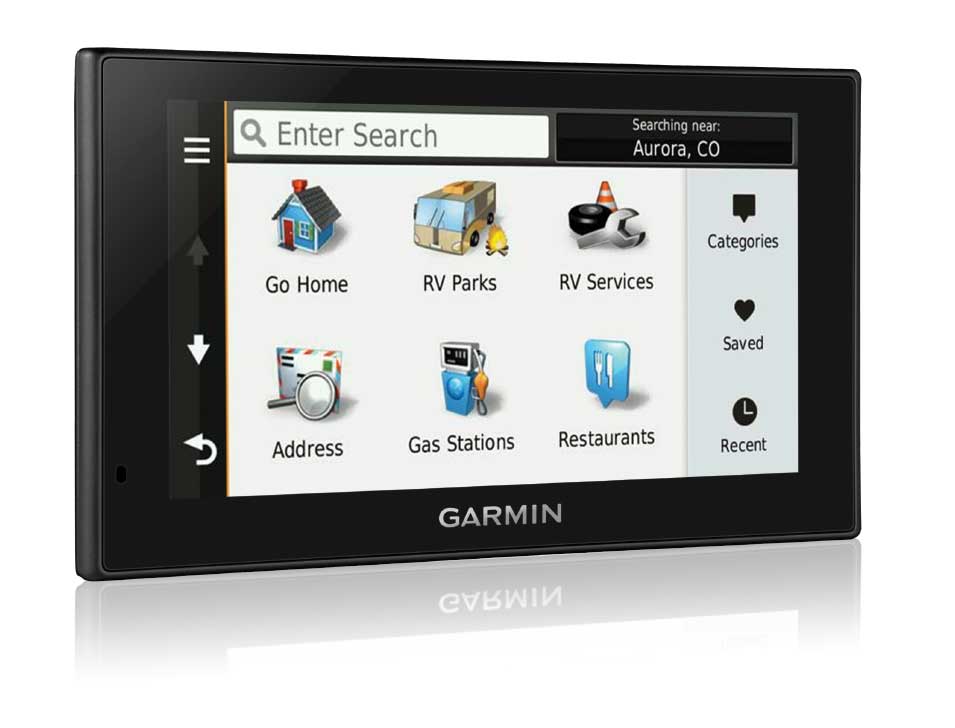
Both Garmin units offer huge databases of RV-specific points of interest including campgrounds, service centers, towing, tire stores, etc. This is one of the features we like best about the Garmin models.
The RV 660LMT is Garmin’s entry-level GPS, but when paired with the Garmin SmartPhone Link app on a smartphone, it gives the GPS many of the functions of a more expensive device. The SmartPhone Link (available on both Garmin devices) opens up some really powerful functions, such as weather (current or other cities, weather radar, weather alerts) and road conditions. There is also a tool called photoLive that allows you to locate Department of Transportation (DOT) traffic cameras (in some states) within 100 miles of your current location and save them. Drivers can look at actual traffic conditions live on the screen. The 660LMT with SmartPhone Link also provides access to Foursquare, which is a social networking program that finds businesses/attractions, etc. The advanced weather and photoLive services require an in-app purchase, but it’s only $5 for each one, so the cost is not major if you value those services. In general, we liked the SmartPhone Link, but we did find it to be quirky at times. On several occasions, we had to unpair the phone, turn off the Bluetooth connection and start over again.
This GPS can define motorhome type, length, weight, etc., and will route around potential obstacles that are not suitable for your setup. It also has an elevation profile to advise the driver of potential issues with upcoming grade changes.
The 660LMT has a one-touch feature on the screen to change from a motorhome to a dinghy vehicle, which is great for those planning on moving it between vehicles. When searching for a campground, both of the Garmin units provide detailed information on each park, such as number of campsites, maximum length, type of electrical hookups, internet access and lots more. This alone gives the Garmin units a huge advantage over the Rand McNally models. The voice-activated navigation allows the driver to keep hands and attention where they belong and simply speak the address or location. The voice navigation isn’t perfect, but it works pretty well if you speak clearly. The lane change/intersection popup screens on these Garmin units were very easy to follow and offered plenty of notice to allow time to get in the correct lane. This is the smallest screen of the group, and it has fairly low resolution since it does not double as a tablet, like the more expensive Rand McNally units.
Since it is not Wi-Fi based, it will be necessary to connect to a computer for map updates, but doing so once a year should not be a major problem. The mounting bracket is a simple suction cup for the windshield and a bracket that connects to the GPS. It offers a good range of adjustability and is not so heavy that it causes the mount to easily come off the windshield.
Garmin RV 770 LMT-S
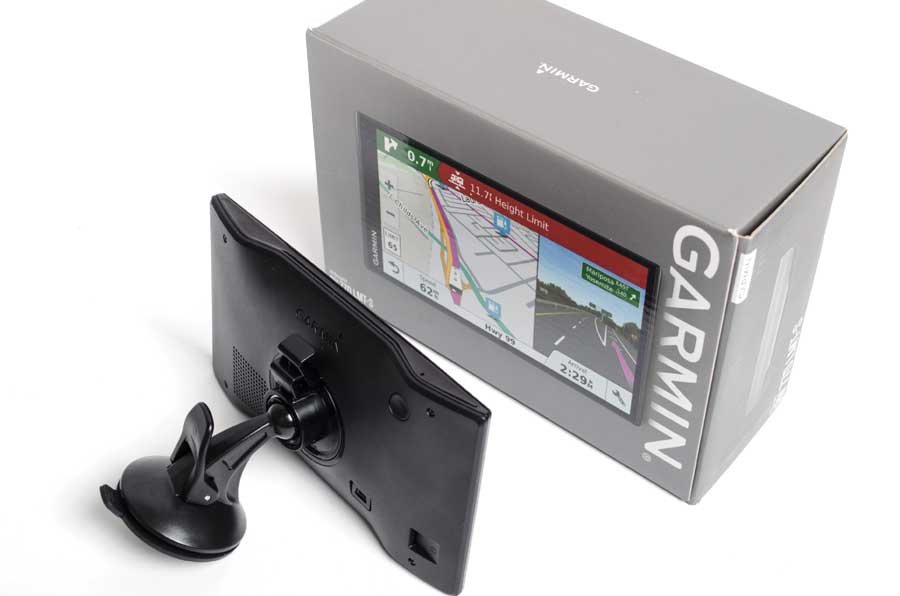
The Garmin RV 770 is a thin and lightweight unit. As a result, the bracket can be smaller because it doesn’t have to support the weight of a heavy tablet-style GPS. This also means that the rear-facing speaker is smaller than the Rand McNally tablet models and the Garmin’s audio suffers.
This model is only $20 more than the Garmin RV 660LMT model we tested, and in our opinion it’s worth the small upcharge. First, it has a bigger screen with higher resolution. When paired with a smartphone you can also receive notifications that would normally show only on the phone. So, if you have various notifications (from apps) enabled on the phone those will now flow through the GPS while driving, allowing the driver to keep focused on the road ahead without having to handle the phone. In addition to Foursquare, the 770LMT-S also has TripAdvisor, which adds even more points of interest (POI) to the database. It even has a feature in SmartPhone Link called LiveTrack that allows the user to share locations with friends or family. This model also has Wi-Fi that allows map updating without connecting to a computer. If you want a GPS only (no tablet), this is the best unit here as long as you don’t need some of the other functions offered by the tablet-based units. Just like the other Garmin unit, it has an extensive library of POIs (more than 14,000 RV-specific locations) for just about any situation or service needed. The voice-activated commands on this unit are usually pretty good. When voice commands are called out, the unit wakes up and is ready for instructions. Commands such as Find Place, Find Address, Go Home and several more are available, and in most cases, the voice system worked well.
Garmin RV 770 LMT-S
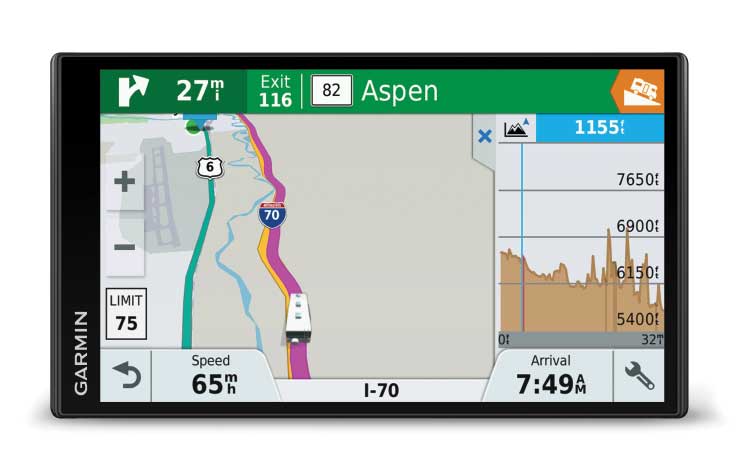
We also tested this model for hands-free phone use and our impression is that it is only fair in this regard. Since the device is so thin, there simply isn’t enough room for a large speaker and therefore it doesn’t work that well when traveling with road noise. When parked — with no road noise — it works pretty well, but if you plan on using this as a main hands-free phone device you may need to look at the Rand McNally tablet models or a headset. The on-screen menus are also super easy to use and, like all Garmin units, these are reliable and really sorted out. Both of the Garmin units also offer the ability to add a backup camera or a Garmin babyCam to monitor other views within or behind/beside the motorhome.
Rand McNally RVND 7
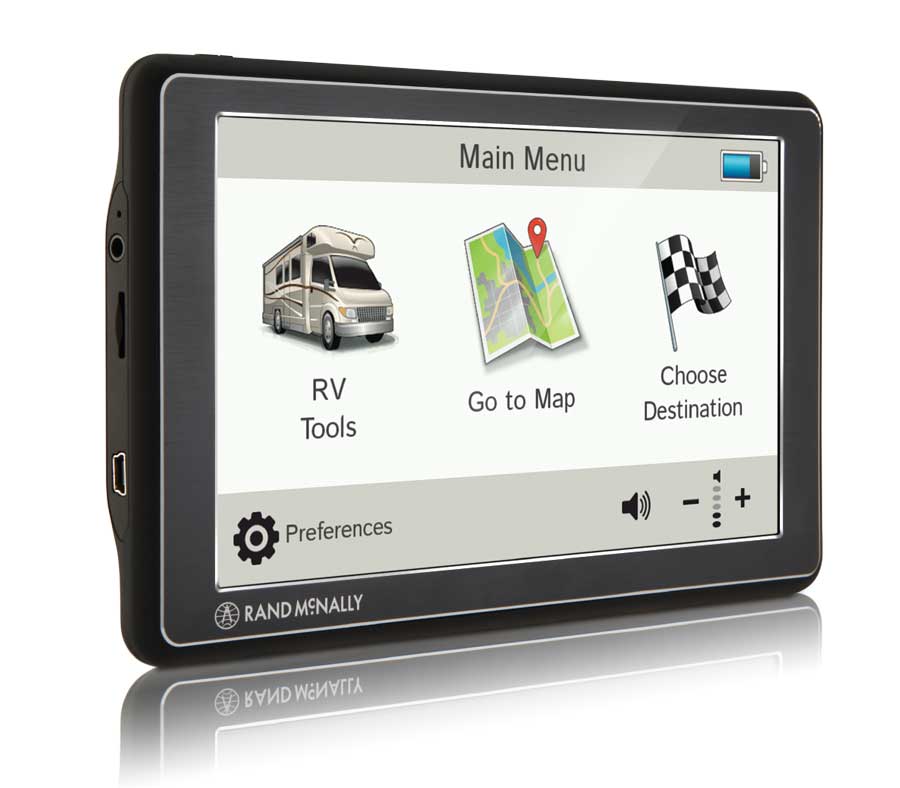
The base model RVND 7 from Rand McNally has a full 7-inch screen and includes free lifetime maps. If you are on a budget, this is a great choice for a GPS.
This is Rand McNally’s entry-level GPS, yet it still offers a 7-inch screen. This model has preset RV types such as Class A, Class A with tag axle, Class B, etc., and then it allows setting customization of length, weight, height, propane tank, width, etc. It includes lifetime map updates, and a warning menu that is user-defined that allows both voice and visual on-screen warnings for things such as narrow roads, state borders, toll roads, construction areas, speed-limit warnings and over-speed warnings. You can even program how long the warnings appear on the screen.
This device also has a “Road Atlas Information” feature for the USA, Canada and Mexico with information about each state, such as the state capital, total land area, largest city, total population, highest and lowest point. This is the only model tested that includes a stylus. Most of the time we simply used our fingers on the touch screen, but when we tried the stylus it really did improve the reaction time and it stores easily on the adjustable mount. This unit does not offer Wi-Fi or Bluetooth connectivity, so in order to update the maps you have to download a “dock” program from Rand McNally. This free software allows you to create an account for the device and update it as needed with a USB cable. The dock program offers some nice features as well, such as a device backup, custom POI import and Good Sam Club trip planner access.
The Rand McNally RVND also offers a nice lane-guidance screen at turnoffs and has a large database of POIs such as campgrounds, service centers, dump stations, restaurants, shopping, etc. Another feature that is very handy is the ability to search for POIs near the current location and route, in a specific city or at your destination. It also displays what is available at the exits along the route, which is a feature we use a lot. The mapping software also allows the user to compare two routes based on preferences saved in the setup menu. The comparison will show the route on a map and specify the miles and time on each route. It even shows if tolls are on the planned route.
This base model also includes some RV checklists for use before starting a trip, and they are user programmable, so list items can be deleted or added. Also included is a fuel log that can be saved on the GPS device and summarized by quarter and year. There is also a built-in calculator and a screen to easily convert units from metric units. The mount is a basic clip-on mount with a suction cup that offers a reasonable, but not great, level of adjustability. Battery life is pretty short, so plan on having this one plugged in all the time. For its price, this is a good, economical unit.
Rand McNally RV Tablet 70
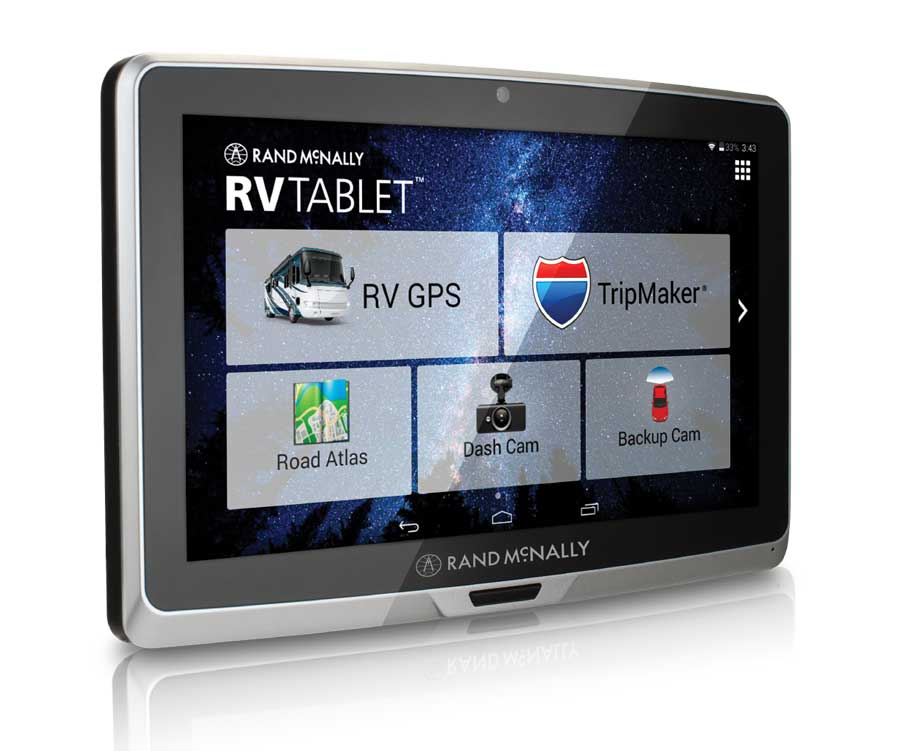
Drivers wanting built-in options like a dash cam will have to consider either of the two Rand McNally tablet models. Shown is the RV Tablet 70 and it includes two cameras; the rear-facing camera is 5 megapixels, while the forward-facing is 0.3 megapixels.
The next step up in Rand McNally’s product line is the RV Tablet 70 with GPS. This is another 7-inch GPS, but it performs a lot more functions than the base model. Since this GPS is also an Android-platform tablet, there is a lot to like here for the additional $100 over the RVND 7. It also includes lifetime maps and, because the unit is Wi-Fi enabled, you can connect the GPS to a smartphone, hot spot or Wi-Fi, performing map and other system updates without any cords.
This model also includes a dash cam with up to six hours of video storage. This one also has weather, a camera, fuel prices and traffic in its feature list and has Firefox as a built-in browser plus a calendar, as well as a link to receive email. You can also store music for playback through the built-in speaker. In order to access the advanced features, such as weather, live traffic, etc., it is necessary to link this device to Wi-Fi or to a smartphone and use its data plan. There is even a menu that shows how much data has been consumed and which of the programs on the device are using the most data. This will allow the user to keep an eye on data consumption if the phone doesn’t have an unlimited data plan.
Along with the functionality of a tablet, Rand also included several RV-specific tabs, such as an RV-leveling app, and a tab for RV park reviews, plus all the other functions found in the base model. One thing the Rand models don’t offer is detailed information on each campground, which can be found on the Garmin units.
This model also has a huge database of POIs for just about anything along a specific route. The RV Tablet 70 also includes the TripMaker app from Rand that is a very powerful tool for planning a trip. Also included is a virtual Road Atlas, which allows users to look at a map of the USA or select a specific region/state; it includes Canada as well.
The RV Tablet 70 has a very strong magnetic mount between the bracket and the GPS, which makes removal easy for use as a tablet. Since this is a tablet, it is heavier than the GPS-only devices, so naturally the bracket and suction cup is bigger. Another thing we noted is that because the tablet-based models are larger, the speakers and battery are larger and in general the audio reproduction — such as phone calls or music streaming — is much better than the smaller Garmin GPS-only models. Overall, this is a solid performer that is very easy to use and full featured.
Rand McNally Overdryve 7 RV
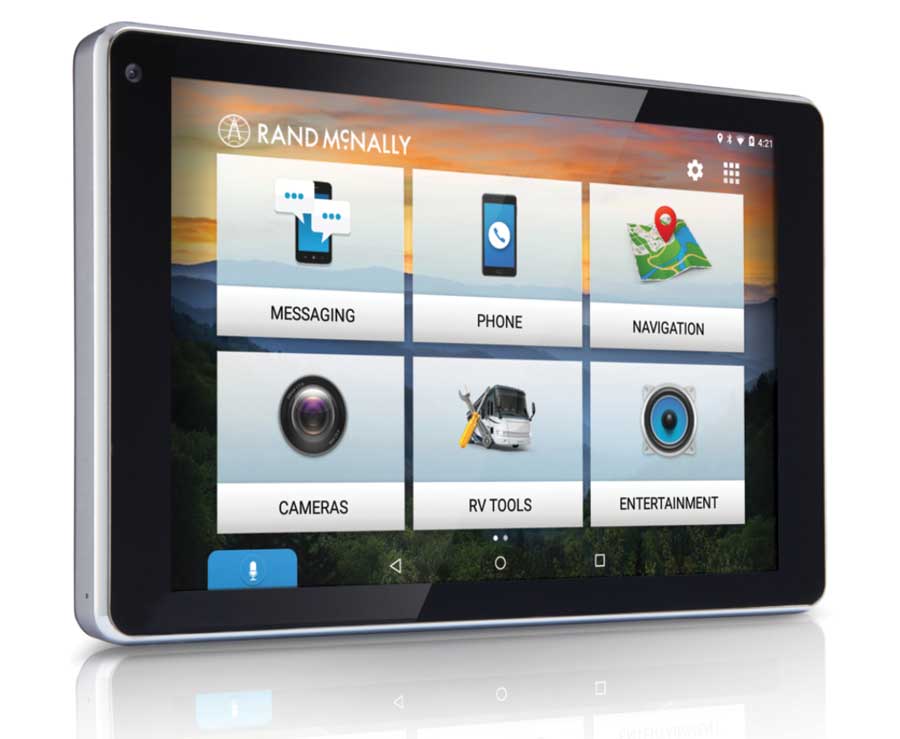
The large Rand McNally OverDryve 7 high-res screen is another reason we like it so much. The integration of the Bluetooth phone connectivity, plus a full-featured tablet and lots more, makes this one of our favorites.
This is Rand McNally’s top-of-the-line tablet with a built-in GPS. In addition to all of the above features on the other Rand McNally units, this one adds voice commands that allow the user to dial phone numbers, send text messages and route to new addresses, etc. On an Apple iPhone, this voice function works through SIRI and you do not have to touch the phone. Once the route is created, the user can follow the map, a highway view or see an overall trip summary. Every item displayed on the screen can be modified, and edited, by just tapping the screen. For example, tapping on the upper right will change the display from 3D to 2D view; tap it again and go to a true north facing up display, etc.
Live data on traffic, fuel and weather can also be displayed at the touch of the screen, as can arrival time, remaining time on the trip or the current elevation. The mount for this tablet features an adjustable suction cup for attaching to the windshield and a magnetic base to hold the tablet in the bracket. The mounting bracket on this model is very large and has its own built-in speakers, which makes it the best performer for audio streaming and hands-free use when making phone calls. We also really liked the voice navigation and found it surprisingly easy to simply speak the address or attraction and the GPS would find it and route us there. Those accustomed to an Apple iPad might be a little disappointed in the performance of the tablet-part of this model, but it’s still not a bad tablet. If used on occasion to surf the web, etc., it will be perfectly acceptable. We really like this model and if you need a full-featured tablet and a GPS, this is our favorite. The only real shortcoming is that neither this nor any of the Rand McNally GPS units offer detailed information on RV parks, which is pretty important for motorhome owners.
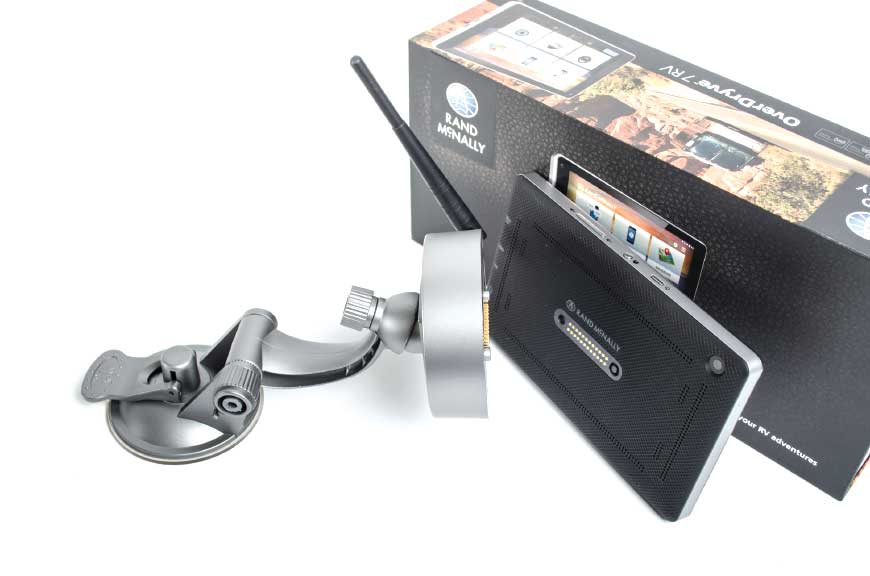
The Randy McNally OverDryve 7 tablet GPS is thicker and heavier than the GPS-only units. This additional weight means it needs a bigger, heavier mount to support it. The magnetic mount shown here makes removing the GPS fast and easy, and the back of the mount has built-in speakers that produce the best audio of the group. Phone calls and streaming music are easily heard while driving.
All of the GPS units we tested are available online or at Camping World. Although we have attempted to point out the major features of each of these units, there are still many aspects that we didn’t cover. As with any electronic device, there are multiple layers of menus and features that will have to be explored to realize their fullest potential. All of these units are very good at providing directions to destinations — the biggest differences being features such as voice commands, Bluetooth, Wi-Fi connectivity, audio and voice quality, and the ability to run apps. Look carefully at the chart on page 39 and determine what you want in terms of features and price, and then choose the one that suits your needs. Overall, our favorite is the Garmin RV 770 LMT-S as the best GPS (only) model. If you want a tablet with a GPS and don’t mind spending the extra money, then the Rand McNally OverDryve 7 RV is a great choice, too.
Sources
Camping World | 888-857-6630
Garmin International Inc.
Rand McNally | 877-446-4863

